WOMEN IN SCIENCE: Learn About Being a Veterinarian, An Interview with Dr. Margaret Wixson
GUEST POST by Helena Donato-Sapp, 10, famous-journalist-to-be

Our friend Helena!
Whenever someone asked me what my favorite subject in school was, I always used to answer, “Recess!” and they would giggle. I do like recess, but not so much everyone giggling at me. I thought about my options. That’s when I decided that science is my new favorite subject
Why did I choose science? First of all, I like animals. We have two Parrotlets in our house named Apple (he is green) and Sunshine (she is yellow).
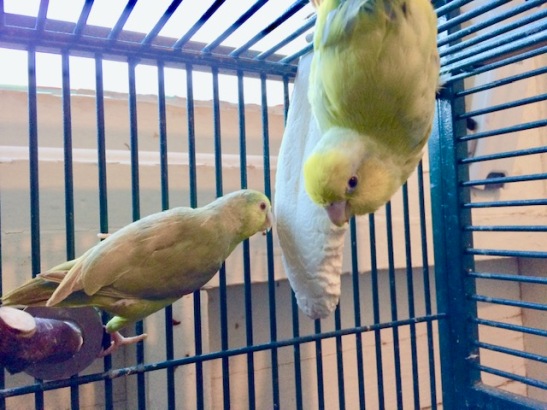
Apple and Sunshine
And I also got a 40-gallon aquarium for Christmas one year and I have a Black angelfish, Tiger barbs, a Sucker fish, snails, and other really interesting fish. One time we saw two of the Tiger Barbs mating! We also have real plants in our aquarium and it is really an interesting ecosystem to study and watch.

Our Aquarium!
And then there is my Auntie Margo. Margaret Wixson is a veterinarian in Portland, Oregon. She first got involved in veterinarian medicine in 2007 by caring for the pets of people experiencing homelessness as a volunteer vet assistant in the San Francisco Bay area. She got her veterinarian degree at UC Davis and there she was a spay/neuter coordinator for more pets of the homeless. She is currently a shelter veterinarian at Oregon Humane Society. Plus, she is a really good aunt.
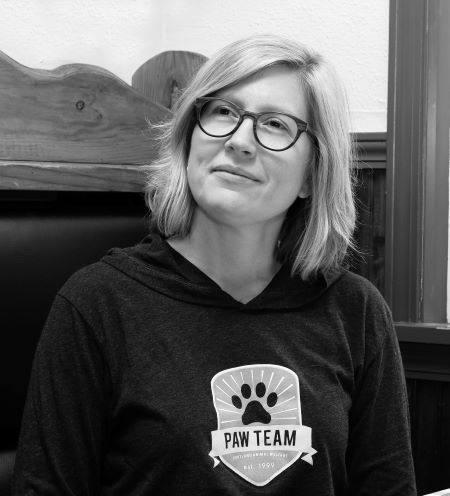
My Auntie Margo
Before you interview someone you really should come up with a set of questions. To do that, you should learn as much as you can before you make up the interview questions. I asked my Dad and Papa to help me find videos and other interesting sites on the Internet. Here are the ones I liked:
- Careers That Count: So You Want to Be A Veterinarian? http://www.inspiremykids.com/2017/so-you-want-to-be-a-veterinarian/
- Veterinarian Volunteer – 4 Great Ways To Start Volunteering With Animals Today https://www.vetsetgo.com/?gclid=CjwKCAjw8ZHsBRA6EiwA7hw_scv0ZPOkGnoBLLCPKVAuic48015yUaAyhvSoMIN_IHhAlFVG990rPRoC5J4QAvD_BwE
- Veterinarian Science https://animalsmart.org/animal-health-animal-welfare/veterinary-science
- How This Vet Talks to Kids About Pet Death http://www.vetstreet.com/our-pet-experts/how-this-vet-talks-to-kids-about-pet-death
I watched these and made up questions as I watched the videos and we read the sites. Easy-peasy.
My Auntie Margo was going to be in Los Angeles visiting her nephew at his college and so we drove to see her and that is when I did this interview with her. We did the interview right in a restaurant.
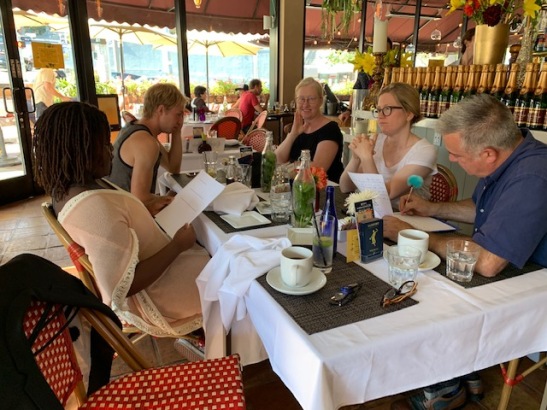
Me and Auntie Margo conducting the Interview!
There are some important things to remember when you’re doing an interview. Here are my top 7 things to remember:
- Be on time. That shows respect.
- Come prepared. Bring your set of questions and leave room to take notes on what your interviewee will be saying.
- Practice your interview from start-to-finish. Don’t wing it. Do the entire interview with a parent or friend before you actually do it with the interviewee.
- If you can, and you have the interviewee’s permission, tape the interview so that you can listen to it again later and make sure your notes are correct. With Auntie Margo’s permission, I had my Papa use his phone and tape us so I could hear it a few times.
- Speak up as loudly as possible and look people right in the eyes.
- After the interview, you can think about what you would do differently next time so that you can improve.
- Be sure to thank the person you are interviewing because they gave you their time and a lot of important information. You could even take them a little plant or a bookmarker that you made to thank them right away.
Here is the question-and-answer interview I did with Auntie Margo.
Why do you love animals?
They’re cute! I love animals because they provide people with a lot of support. The support can be direct, meaning that they are a guide dog or something like that. Or the support can be friendship and companionship. Whether it is support or friendship, animals make people happy and people make animals happy.
What are some of the strangest or most unusual animals you have seen?
I don’t work with exotic animals, so the more unusual animals for me are chinchillas, rats and birds. I have seen some unusual animals at the zoo though.
Have you ever seen an animal with rabies? What was it like? What should I do if I see an animal with rabies? What do rabies look like?
There are two forms of rabies. There is the dumb form and with this kind of rabies the animal will appear tired. The second kind of rabies is the aggressive form and these animals will bite and lash out. Animals with rabies can also show neurologic signs as well, like seizures.
Rabies is a zoonotic disease. That means that it is a disease that can be transmitted from animals to humans. It spreads when a person gets close to an infected animal’s bites, scratches, and saliva. Only mammals can get rabies.
The things you can do to protect yourself are to make sure that any pets are vaccinated. If you see an animal acting strange, report the animal to your County Health Department. Really the most important thing to remember is to never touch a bat! Bats are more likely to have rabies.
Have you ever treated an animal from a zoo?
No, but I once went to a zoo cardiac exam for a gorilla.
What is the biggest animal you have treated?
The biggest animals are horses and that gorilla one time. I did, though, work on a 147-pound English Mastiff dog once. It was huge!
I understand that there are very few veterinarian colleges and that they are hard to get into. Did you do volunteer work before you went to school? Where?
I volunteered at animal shelters and the Humane Society.
What was your undergraduate degree in?
My undergraduate degree was in Asian Studies and Chinese. I had a pre-health certification and wanted to go into medicine.
As a doctor for animals, how do you communicate and talk with animals to find out how they are sick?
I have to look at them to tell if they are sick or not. For instance, if I am concerned about an animal being dehydrated, I will check their skin, eyes, and gums. If I’m concerned about their digestive tract or urinary tract, I feel their bellies.
What is the grossest thing you have ever seen or had to do?
The grossest thing was a cat that had maggots in the leg. You could actually hear them eating the cat’s leg. The poor cat died from that.
An Aside: I thought everyone might want to see some of the gross pictures Auntie Margo showed to us. Some of them are just so gross that I can’t show them. My Dad was really freaked out by them!
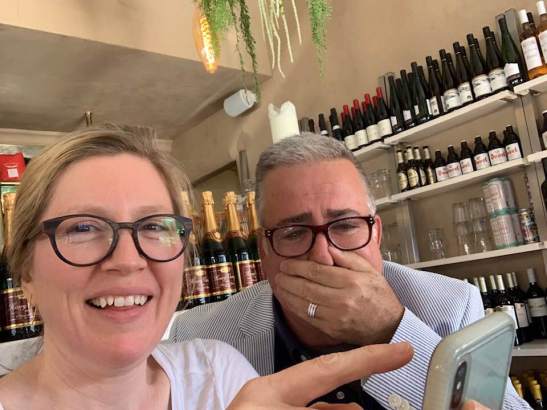
WARNING: Some Medical photos below!
Here is one picture of a poor dog that got too close to a porcupine and got all kinds of quills stuck in its face
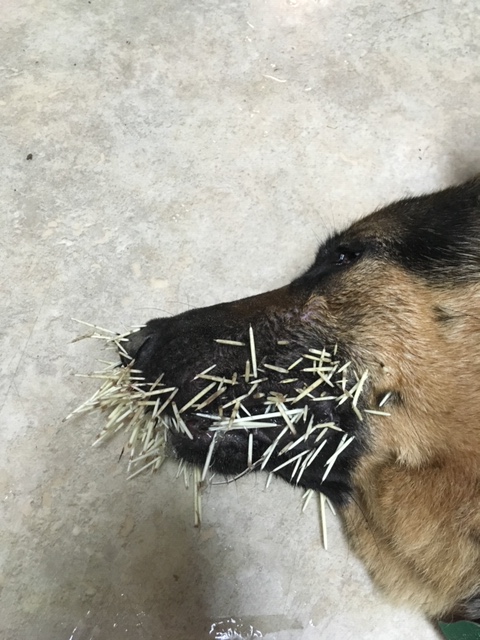
Dog with Porcupine Quills
And the picture of this cute little kitten is sad, too. Auntie Margo said it had a really bad infected eye and you can see how red it is in this first picture
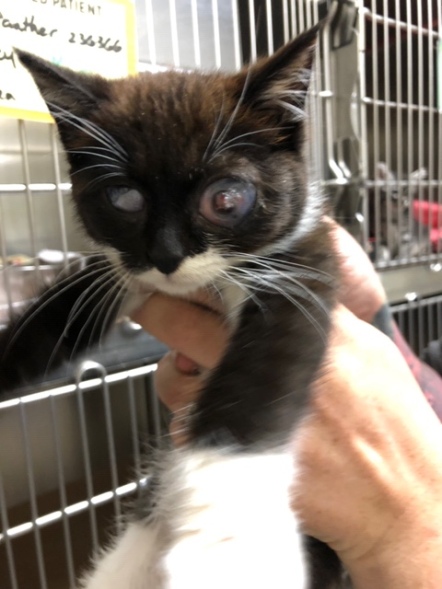
Cat with infected eye
In the second picture you can see that they had to remove the eye and Auntie Margo sent me a picture of the eye!
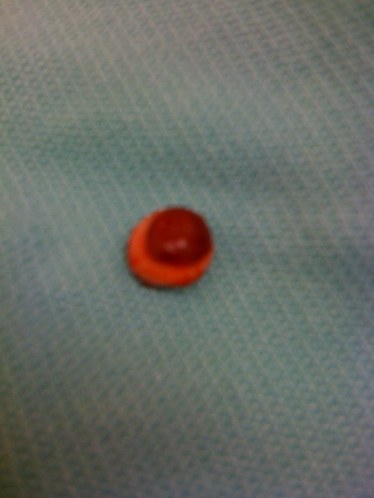
Picture of the removed eye
But she wanted us, also, to know that the kitten was fine and got adopted by a family and lived happily ever after. This next photograph of a kitten was just to show us how small it was when someone brought it to the shelter. It is so tiny!
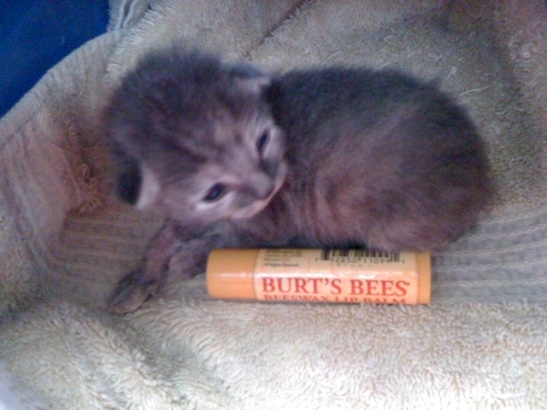
Small as a tube of chapstick!
Do you wear blue doctor’s clothes?
Yes, I wear scrubs.
Have you ever seen a monkey?
No, not as a veterinarian, but I did see that gorilla and that is close.
What do you do if you think someone is being mean to their pet and hurting it?
That’s a great question, Helena! If I suspect something is wrong, I report it to the Sheriff and the Sheriff goes and interviews the person. I also take photographs so I have documentation and I keep really good records. Unfortunately, I see animals that are being treated poorly all the time; it is very sad.
Are you a specialist at something?
I focus on shelter medicine and on animals that are in animal shelters.
How do you handle owners who are really emotional about their sick pet?
I don’t actually work with them a lot, but when I do I just try to give them a lot of information.
Since you’re a doctor and you might get a call anytime at all, how does your husband – Uncle Julian – support your work?
He goes mountain biking and has his own hobbies that keep him busy and that allows me to work long hours and not worry about him. He also takes care of our pets when I am gone.
Which question that I have asked did you especially like and which question surprised you?
I really loved the question about what happens when I suspect that a human is hurting an animal and what I do. And I think I was surprised that you wanted to know all about the gross stuff!
LEARN MORE ABOUT MY AUNTIE MARGO
- Concordian doctors pets, both on and off the job http://concordiapdx.org/2019/06/concordian-doctors-pets-both-on-and-off-the-job/
- Doggie Dash Challenge Day https://katu.com/afternoon-live/lifestyle-health/ohs-medical-center-overview
- Happy Ending for Eevee https://www.sierrastar.com/news/local/article95943877.html
READ ALL ABOUT IT
There are lots of books on veterinarians and how to become one if you’re interested in that job. Here are two good ones I read before my interview with Auntie Margo.
I Want to Be a Veterinarian ($10.99) by Stephanie Maze. This book is perfect for you if you think you want to be a veterinarian someday. It has really good pictures, lots of information about different kinds of vets, the history of animal science, and where veterinarian medicine might go in the future.
Be the Vet (7 Dog + Cat Stories: Test Your Veterinary Knowledge) by Ed Blesy ($7.99) is really fun because you get to pretend you are the veterinarian. What do you do if a dog stops eating or a cat throws up or a pet just won’t stop itching itself? You get to figure out what is wrong and suggest what to do to make the animal better. Then a real veterinarian tells you what they would do. You will learn a lot of veterinarian terms.
WHAT TO DO WHEN A DOG OR CAT DIES
Cynthia Rylant is an author I like because she is from the same state as my Grandma and Grandpa. She was born in West Virginia, but now she lives in Oregon. She wrote an amazing book for when a person’s dog dies and it is called Dog Heaven ($7.60) and it is really good. It will make you cry. Our family gives this book to anyone who has a dog that dies and they always love the book. Guess what? Cat people were upset and she kind of had to write Cat Heaven ($13.73) for them. It doesn’t seem fair that the cat book costs more than the dog book, but either way I know people like it when we give them the books. The book is a nice way to help people mourn the loss of their pet they loved so much. I know we have given this book away dozens of times to help our sad friends.
IF YOU WANT TO DO MORE
I found some great online activities at the Nebraska Humane Society. They let you come and read stories to the animals. Awesome! They have some cute puzzles that you can do that have to do with animals and being a responsible pet owner. They have a coloring page of a happy cat living inside the house. My favorite thing, though, is that they have recipes for cat cookies and dog cookies. They have a whole list of great things to do in your community so check it out: http://www.nehumanesociety.org/community-services/youth-programs/kids-activities/.
Find out more about The Humane Society at www.humanesociety.org.
GLOSSARY
Sometimes when you’re learning about something new, like being a veterinarian, there are new words to learn. Here are some of the words that I had to look up and learn about as I was learning about being a veterinarian. A lot of these words came up because of my interview and I had to learn them to understand some of the answers.
Aggressive form rabies: Rabies is a viral disease that makes animals aggressive. Aggressive form of rabies can also be called furious rabies.
Cardiac: Cardiac means it is about the heart.
Chinchillas: A chinchilla is a small South American rodent and it has soft gray fur and a long bushy tail.
Dehydrated: Dehydrated is when a body loses a lot of water.
Digestive tract: The digestive tract is your guts, that part of the body that takes in food, digests it, and then gets rid of it.
Dumb form rabies: Dumb rabies is a type of rabies that paralyzes an animal and makes it weak.
Ecosystem: An ecosystem is a biological group of organisms living in their physical environment, like the fish and plants in my aquarium.
Exotic animals: Exotic animals are rare or unusual ones that aren’t usually kept as pets.
Guide dog: A guide dog is a dog that has been trained to help a person with disabilities.
Interviewee: This is the person who you are going to interview like, in my case, it is my Auntie Margo.
Interviewer: This is the person who is doing the interview.
Maggots: A maggot is a soft-bodied legless larva that is usually found in decaying flesh.
Mammals: A mammal is a warm-blooded animal that has hair or fur, feeds its babies with milk, and has a live birth and not an egg.
Mourn: When someone or something dies then you mourn it, which means that you feel deep sorrow/sadness.
Parrotlet: A parrotlet is a tiny tropical parrot with a short tail.
Spay/neuter: When you spay a pet, you remove the reproductive organs of the female dog or cat. When you neuter a pet, you remove the testicles in male dogs and cats.
Transmitted: When something is transmitted it is passed from one to another.
Urinary tract: The urinary tract has to do with the parts of the body that produce, store, and get rid of urine (or pee). These organs would be the kidneys, ureters, bladder, and urethra.
Vaccinated: Vaccinated means that you treat a mammal with a vaccine so that it will be able to resist a particular infection or disease.
Zoonotic disease: This means that a disease (like rabies) can be transmitted from animals to people.
—————————————————————————————————————————————–
Wow, Helena, what an amazing post! I’m so glad and honored that you chose to send it to kidsanimalstation. Know that me and my followers appreciate and love your work, and send another post anytime!
If you are a kid who loves animals and wants to make a guest post for our blog just like this one, contact us! It is a great way to communicate a message to other kids who love animals and their parents, good for strengthening writing skills (which I’m sure our friend Helena could tell you about) and impressive for a resume! Email: zoejane24@icloud.com
-Zoe, Founder of Kidsanimalstation
